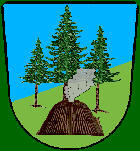

The name "Köhler" (Koehler) is derived from
an old occupation, that meanwhile almost died out in Germany. For many
chemical processes, like iron smelting or glass production high temperatures
are necessary. Also to forge iron or process noble metals heat is needed.
In areas without natural deposits of coal, but richness of forest, the
Köhler (i.e. charcoal burner) made the necessary coal by charring
the regenerating raw material wood. Today's humans think of barbecue parties
when thinking of charcoal. Technical heat is generated by electricity or
oil today. But in former times charcoal in gigantic quantities was needed
for the early industry. This led to the extermination of whole forests.
The Augsburg local recreation area "Stauden" (i.e. shrubs) owes its emergence
to the immense need of wood for the city of Augsburg in earlier years.
To anyone interested in old, died out jobs, Rudi Pallas' book "Das Lexikon der untergegangenen Berufe" (= The encyclopedia of the gone down occupations) may be recommended. To the topic "charcoal burners" the following lines are found there: Charcoal burners lived usually in the lonely remoteness of dark forests, where they charred wood to charcoal in charcoal kilns (charcoal piles). Their way of life was quite poor and laborious. Day and night they had to be watchful, and the few hours, which remained for resting, they spent in primitive huts (so called Kothen) on a bed made of brushwood and barks. It is reported, the existence of charcoal burners was characterized by lack of sleep, a "continuing state of anxiety" and "scarred burns". Their daily meal often was a thin soup of water only; now and then they caught a hare or a fox. They were considered to be rebellious lads, which took their symbols and rites for example of the Carbonari, a secret political federation, which developed during the French rule over Naples 1806. The "cleaning of the forest of wolves", which meant the fight against tyranny, was the basis of their symbols. The members called themselves "Gute Vettern" (good cousins, the meeting place was called Hütte (hut) or baracca, the inside of the hut was the "Kohlenverkauf" (coal sales) or vendita. They strove for national independence and liberal systems of government. Also women worked as charcoal burners. In the east Alps this was a common job for older, stiff forest workers, and in the Pyrenees leprosy patients and their descendants did that job. Charcoal was the most important fuel for the smelting and processing of iron in earlier times. The blast furnaces devoured enormous quantities of charcoal. Forrest officers of the English king counted 2,290 charcoal kilns only in the forest of Dean, which had an area of 40,000 hectares (=154 sq. miles), at the end of the 13th century. Where the wood could not be charred directly at the cutting as in the mountains, the trunks had to be floated as rafts on rivers in summer or transported on sleighs in winter. Down in the valleys the wood was charred on central places, often near sluices or artificial ponds. In Austria such places were e.g. at the river Enns near Hieflau and Großreifling, where at the beginning of the 19th Century 12,000 to 18,000 Klafter (= 50,000 to 80,000 cubic-yard) wood were charred annually. With the production of charcoal in kilns, usual
since the antiquity, healthy, air-dry blocks of wood were put on around
stakes (called quandel) and covered with a hermetic layer of grass, leaves,
moss and damp forest earth. Now the fire pit in the middle of the kiln,
filled with brushwood, dry leaves and peaces of wood rich with resin was
ignited. After six to eight days the whole kiln "cooked". At a temperature
of three hundred to three hundred fifty centigrade evaporated water, tar,
carbonic acid, carbon dioxide, hydrogen and hydrocarbons, and the charring
process began. The task of the charcoal burner was it, to "direct" the
temperature of the kiln by the amount of air, closing and opening holes
in the coverage, in such a way, that the kiln neither expired, nor came
into bright flames and "went through". Day and night the kiln had to be
examined and controlled with intuitive feeling. Large kilns with a volume
of sixty to one hundred cubic meters burned in good weather usually for
several weeks. One charred also in pits and starting from the end of the
18th Century in industrial furnaces. Lying kilns, with the wood laminated
in horizontal layers around the axle, were particularly common in Eastern
Europe and Scandinavia.
Tried to translate from "Das Lexikon der untergegangenen Berufe" by Rudi Palla, Bechtermünz Verlag, ISBN 3-8289-4152-4. |